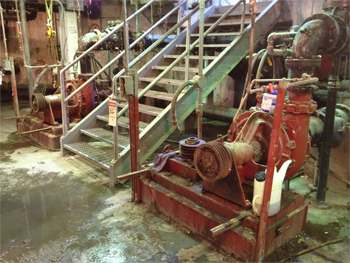By Douglas Reed, Roger Stephenson, Steven Hyland and Joshua Hutson – MWH Global
Introduction
When Hurricane Sandy slammed into New York City on the evening of Oct. 29, 2012, few places were harder hit than the Rockaway Peninsula in Queens. As the sun rose the next morning, hundreds of homes in Rockaway’s Breezy Point neighborhood lay smoldering and hundreds more had filled with seawater. Amid the disaster, the Rockaway Wastewater Treatment Plant (WWTP), which serves more than 100,000 residential and business customers, was inundated and inoperative. The combination of high tide and storm surge had poured water from Jamaica Bay into the plant’s below-grade components, resulting in a complete shutdown of the 45-mgd facility designed to produce disinfected secondary effluent.
New York City’s Department of Environmental Protection (DEP) quickly began the process of bringing the Rockaway plant back online with DEP staff, on-site engineering and construction management consultants, and construction contractor staff. In addition, outside wastewater facility specialists were mobilized to assist with assessments, work priorities, and construction and repairs oversight. With this help, the DEP was able to treat 99 percent of all wastewater within five days of the storm, and 100 percent within two weeks. This article explores the flood impact, organization of the recovery effort to bring the plant back online, key action steps and lessons learned that could help other facilities improve their disaster resiliency plans.
Flooding of the secondary digester building at Rockaway Wastewater Treatment Plant, NY
Plant design and extent of the flooding
The Rockaway WWTP follows the typical design for facilities constructed in densely populated urban areas with many of the necessary support systems located in below-grade tunnels and galleries. As a result of the coincident storm surge and high tide, seawater inundated plant areas located below an elevation of 11 to 12 feet mean sea level (two to three feet above existing grade). This meant that many of the critical systems needed for the operation of the plant, including the main sewage pump stations, sludge pumping equipment, electrical systems and even the spare parts storage area were rendered inoperative and inaccessible, hampering cleanup efforts.
Organizing the recovery effort
New York City’s DEP led the recovery efforts, setting up an Incident Command Center (ICC) to oversee all work and assist the plant operations team responsible for the operation and maintenance of the facility. The DEP also immediately mobilized a team of design engineers, construction managers and contractors familiar with the facility, including a team from MWH Global, an environmental engineering firm. After establishing an organizational structure, the ICC and support team began implementing
the myriad tasks—assessing, prioritizing and initiating repair work—needed to bring the plant back online and compliant with its permit.
Actions
After the DEP performed the initial assessments, the team of planning engineers and construction managers set about determining the extent of the damage and prioritizing recovery efforts. The team’s first priority was to ensure the health and safety of those working on the site by initiating air monitoring, dewatering, cleaning, disinfection, and the restoration of power, lighting and ventilation.
Aeration tanks at Rockaway Treatment Plant, NY
Once the safety of the facility and personnel had been established, temporary raw sewage pumping systems were installed to dewater the plant headworks area and convey raw sewage to relieve surcharging and overflows from the wastewater collection system. Subsequent activities included the restoration of screening, raw sewage pumping, disinfection, and primary sedimentation basins to achieve primary treatment, followed by the restoration and recovery of aeration basins, secondary sedimentation basins, and ancillary treatment components to achieve secondary treatment.
DEP maintenance teams collaborated with contractors working 24 hours a day, seven days a week, in a coordinated effort to restore plant systems. Together, they successfully brought the plant back to capacity within two weeks, despite the arrival of winter storm Athena, a nor’easter that passed through the New York City metropolitan area just days after Sandy departed.


